ISSN ONLINE(2278-8875) PRINT (2320-3765)
ISSN ONLINE(2278-8875) PRINT (2320-3765)
K.Binishiny1 and T.Rajesh2
|
| Related article at Pubmed, Scholar Google |
Visit for more related articles at International Journal of Advanced Research in Electrical, Electronics and Instrumentation Engineering
This paper presents the extraction of vehicle license plate information from a sequence of various images. ALPR is used in the presence or absence of a database in various applications such as, toll payment, etc. The proposed technique implements the CAN image by using a camera and to extract the license plate from the image based on various characteristics, such as the boundary, the color, or the existence of the characters. Thus it is not suitable for location of variable number plate. Finally to recognize the extracted characters by template matching by using neural networks and fuzzy classifiers.
Keywords |
| vertical edge detection algorithm (VEDA), scale-invariant feature transform(SIFT), dynamic programming(DP). |
INTRODUCTION |
| Automated License Plate Recognition (ALPR) is a technology that uses optical character recognition (OCR) to automatically read license plate characters[1]-[3]. |
| Automatic License Plate Recognition has many uses including: |
| • Recovering stolen cars. |
| • Notifying drivers with an open assurance for arrest. |
| • Catching speeders by comparing the average time it takes to get from stationary camera A to stationary camera B. Determining what cars do and do not belong in a parking garage. |
| • Observing the notion of cars and do not belong in a parking garage. |
| • By eliminating the parking as expedited which is the need for human confirmation of parking passes. |
| The organization of the paper is mentioned as follows. In section II, a detailed review of ALPR Technique. Section III , illustrates the various algorithms used in ALPR Technique. Section IV features out the proposed method. Section V and VI narrates the experimental and simulation results and Section VII concludes the paper and defines the future works. |
ALPR TECHNIQUE |
| ALPR is known by several other names, including Automatic Number Plate Recognition (ANPR), Automatic Vehicle Identification (AVI), Car Plate Recognition (CPR), License Plate Recognition (LPR), and Lecture Automatique de Plaquesd’ Immatriculation (LAPI). Other name of ALPR are followed as car plate recognition, automatic vehicle identification, and optical character recognition for cars[5]. |
| Optical character recognition, usually abbreviated as OCR, is conversion by electronic and mechanical of scanned images which may be of writing by hand, or printed characters and numbers into machine-encoded format of characters and numbers. It is widely used as a form of data entry from some sort of original paper data source, whether documents, sales receipts, mail, or any number of printed records[4]. |
| It is a common method of digitizing printed characters and numbers so that they can be electronically searched, stored more compactly, displayed on-line, and used in machine processes such as machine translation, textto- speech and text mining[6]-[8]. |
| Early versions needed to be programmed with images of each and every texts at a time implied on a single font. "Intelligent" systems with a greater degree of recognition accuracy for most fonts are now common[10]. Some systems are capable of reproducing formatted output that closely approximates the original scanned page consists of various images, columns and other non-textual components. |
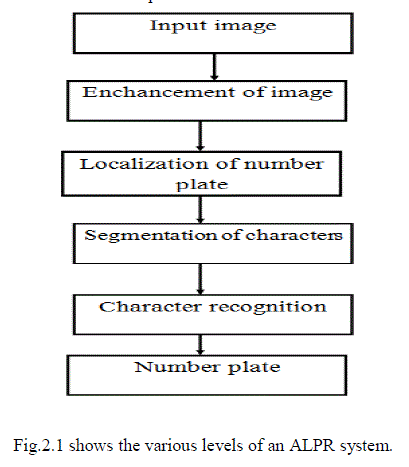 |
ALGORITHMS USED IN ALPR TECHNIQUE |
| The ALPR system comprising of four levels from the input image results during the extraction of a license plate number. |
| • The first level is the location of an image of a car by utilizing a camera. |
| • The second level is the extraction of a license plate from the given input image based on the following features as boundary, existence of the characters and the color. |
| • The third level is the character extraction and segmentation of license plate. |
| • The final level is the recognization of character extraction by the matching of templates such as fuzzy classifiers. |
| This paper illustrates the procedural types of various algorithms, They are as follows: |
| • Block Converter |
| • Otsu |
| • State-of-art |
| A. Block converter |
| Block converter is the converter ,which is used to convert the image to sub blocks from the sub block , use selected box only for segmenting the number plate. |
| The block-based method is also presented in which the blocks with greater magnitude edges are visualized as areas of license plate. |
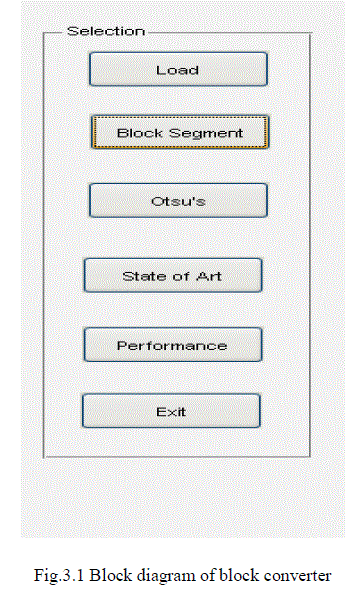 |
| B. Otsu |
| The number plate consist of fore ground information and back ground data. In this algorithm the necessity of numbers only utilize the threshold segmentation. |
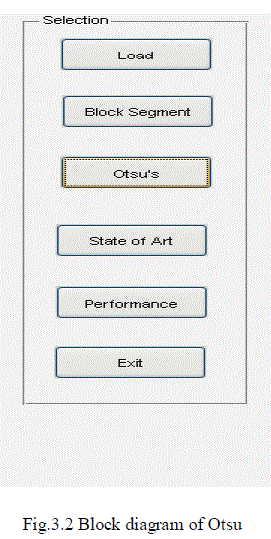 |
| Extraction methods based on this scenario are called hybrid extraction methods . Extraction of texture features and color features are utilized in fuzzy rules. From the sample images, the yellow color values are gained and are utilized for the color feature to train the fuzzy classifier. Utilization of Gabor filter, threshold and connected component labeling for obtaining the region of plate |
C. State-of-Art |
| It is the feature based process. Training data convert to feature points. Feature point only depends upon the shape of the training image. Then it is compared to the number plate feature points[11]. Both feature point can be compared by using State-of-art and produce the character which measures the best between the training image and the number plate image. |
| Backgrounds of license plate and characters has varying colors, possessing opposite binary values in the binary image. Horizontal projection of used to extract the characters along with noise removal and analyzing the simplicity. To convert grayscale im-age into a binary image by using a threshold operation. There are basically two types of threshold operation: |
| • LOCAL Thresholding |
| • GLOBAL Thresholding |
| The proposed approach enhances a solution for the vehicle license plates that are majorly degraded. |
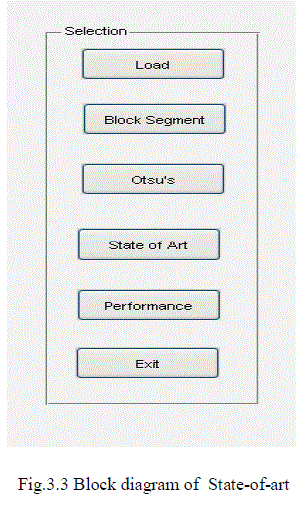 |
PROPOSED METHOD |
| Fuzzy clustering methods, however, allow the objects to belong to some of the clusters appropriately, with various levels of membership. In addition, fuzzy clustering is more natural than hard clustering. Objects on the boundaries comparing with different classes are not forced to fully belong to one of the classes, and assigning the membership degrees between 0 and 1 identifying their partial membership. The discrete nature of the hard partitioning also creates complexities with algorithms based on analytic functionals, since these functionals are not distinguishable. |
EXPERIMENTAL RESULTS |
| Extraction of the license plate influence the accurate recognition of an LPR system. All license plate has a rectangular shape with a valid aspect ratio can be utilized for calculating all rectangles in the input image. To calculate these rectangles various edge detection methods are used. CCA is an important technique in processing the binary image. The binary image is scanned by CCA and pixels are labeled into components depends on the connectivity of pixels. This method is based on the characters visible in the license plate, which yields the variation between in color and background color of license plate in the gray-scale level. |
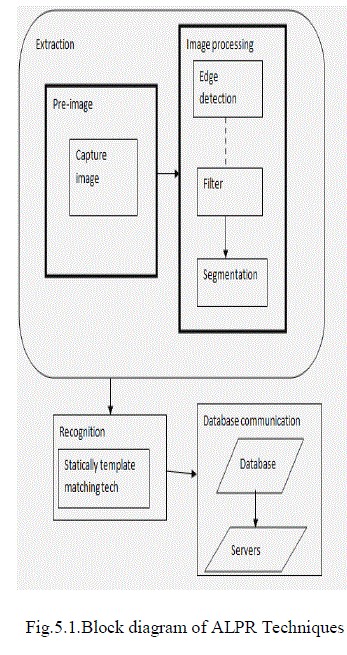 |
SIMULATION RESULTS |
| Graphical user interface designed from MATLAB GUI tool box and Image processing toolbox can be added by MATLAB mfile. Input car image is then loaded from hard disc and converts the color image into grayscale conversion using color transform. |
| The extracted are characters are then recognized and yields the output is the license plate number. Character recognition in ALPR systems have some difficulties. Due to the image zooming factor, the extracted characters do not have the same size and the same thickness. |
| All character pixels does not have the similar importance in differentiating the character, a feature extraction method that extracts some features from the character extraction is a good alternative to the grey-level template matching method. |
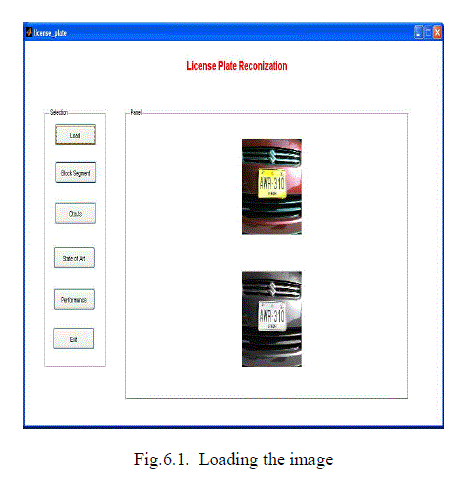 |
| Block segmentation is provided image cluster into 84*84 image. Three dimensional array convert to twodimensional format using color transform, which is converted to sub-blocks using array transform techniques. |
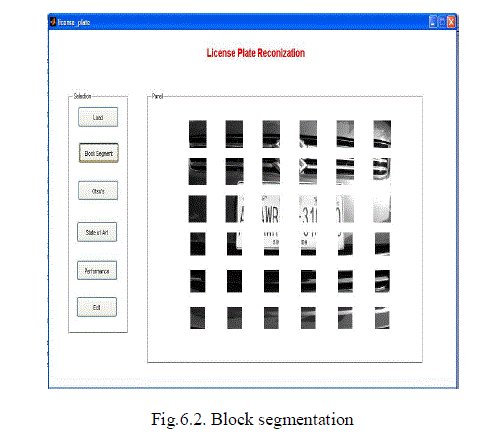 |
| Otsu segmentation process which is optimal threshold then single threshold can be applied for image segmentation, it’s used to number can be extracted from number plate. It discriminates the number and background object. |
| Analyzing the labelled pixels having the same size and aspect ratio of the characters are mentioned as license plate characters. It fails to extract the characters when these pixels are joined or broken characters. |
| Hough transform is utilized to correct the rotation the problem hybrid binarization technique is used to segment the characters in the dirty license plate, and feedback self-learning procedure is employed to adjust the parameters. |
| A method is described for partitioning the main numeric characters on a license plate by the introduction of dynamic programming (DP). |
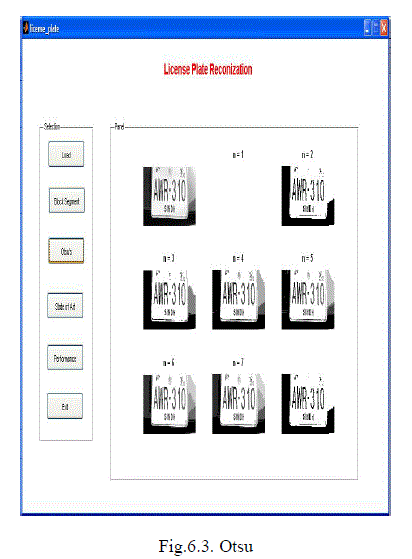 |
| Number image to text conversion using State-of-ART .This technique consists of training image .The number shape can stored from training database. |
| Otsu method: |
| Otsu’s thresholding selects the threshold to minimize inside the class variance and maximize outside the class variance between a segmented foreground object and background. |
| All possible thresholds (0-255..) are evaluated in this way, and that one that maximises the criterion is chosen as the optimal threshold. |
| Recursive method |
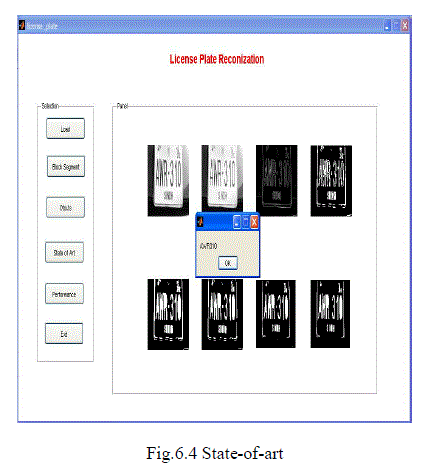 |
CONCLUSION |
| License plate extraction from the existing stage may have various problems such as tilt and non-unifrom brightness. In addition to the processing of each pixel in the input image, which yields in the rise of the processing time, the license plate is varied by its features, hence the system processed these pixels based on its features, such as color, shape, character recognition, etc. In future single threshold segmentation will be promoted to multi threshold algorithm such as Fuzzy C means segmentation for number extracted from plate. |
References |
|